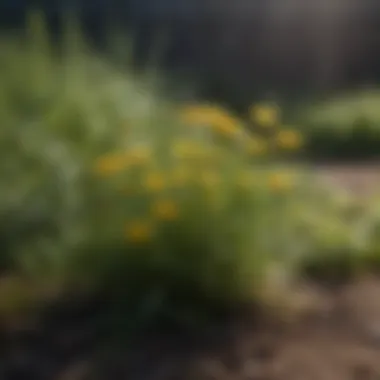Mastering Weeds: Identification and Management Tips


Intro
Managing weeds in your backyard is not just a chore; it is a critical aspect of maintaining a healthy garden. Weeds can disrupt the growth of desirable plants, leading to a less vibrant landscape and contributing to soil degradation. This article seeks to provide you with a deep understanding of these invasive plants, focusing on their identification, impact, management strategies, and preventive measures. Through an exploration of both the biological aspects of weeds and practical gardening techniques, we aim to offer a comprehensive resource for homeowners and gardening enthusiasts alike.
Topic Overview
Definition and Importance
Weeds are typically defined as any plant that is considered undesirable in a specific situation. This usually refers to plants that compete with cultivated plants for resources such as sunlight, water, and nutrients. Understanding what constitutes a weed is essential for effective management. Weeds can harbor pests and diseases, disrupt soil health, and reduce crop yields if not controlled.
Brief History and Evolution
Historically, weeds have coexisted with cultivated plants for centuries. Ancient farmers recognized the need for weed management to protect their crops. Over time, various strategies have evolved, from manual removal to the application of herbicides. Understanding this historical context can provide valuable insight into current weed management practices and highlight the importance of sustainable methods.
Key Techniques and Innovations
Sustainable Farming Practices
Sustainable farming practices emphasize the importance of working with nature to promote a balanced ecosystem in your backyard. Organic mulching, using cover crops, and employing crop rotation are all sustainable techniques that can reduce weed competition.
- Mulching: Applying a layer of organic material to the soil surface helps suppress weed growth and retains moisture.
- Crop Rotation: Alternating crop types each year can disrupt the life cycles of weeds.
- Companion Planting: Planting certain crops together can provide natural weed suppression.
Advanced Agronomic Technologies
Innovations in agricultural technology have transformed weed management. Tools such as precision agriculture, which uses technology to assess weed pressure, can greatly enhance the effectiveness of control measures.
- GPS Mapping: Allows farmers to identify weed hotspots and manage resource allocation accordingly.
- Drone Surveillance: Drones can monitor large areas for weed infestations, which aids in timely intervention.
Practical Applications
Step-by-Step Guides
- Identify the Weeds: Start by learning to recognize common weeds in your area. This can include plants like dandelions, crabgrass, and clover.
- Assess the Impact: Determine how the weed affects the health of your plants. A mild weed may need only occasional attention, while a more aggressive species will require immediate action.
- Select a Management Strategy: Decide whether you want to remove the weeds manually or use herbicides, keeping in mind the impact on the surrounding ecosystem.
- Implement Control Measures: Apply the chosen method consistently to keep weed populations in check.
- Monitor Progress: Regularly check your garden for new weed growth and adjust your strategies as needed.
Case Studies or Real-World Examples
Case studies in urban gardens highlight the success of combining manual weeding with mulching techniques. A homeowner in Portland, Oregon, reported a significant decrease in weed growth by applying cardboard and organic mulch around their vegetable beds. This practice combined traditional methods with innovative thinking to enhance garden health effectively.
Effective weed management is about setting the right balance between control and fostering a thriving garden ecosystem.
By understanding and managing weeds properly, you can ensure that your backyard remains a beautiful and productive space.
Foreword to Backyard Weeds
Backyard weeds are not just inconvenient plants; they hold significance in the realm of gardening and land management. This section will explore the foundational aspects of weeds that every homeowner and gardening enthusiast ought to grasp. Understanding weeds helps in taking effective measures to manage them effectively, which ultimately leads to a healthier and more aesthetically pleasing garden.
The Definition of Weeds
Weeds are defined generally as any plant that is considered undesirable in a particular context. Most of the time, they interfere with the desired plants in gardens, lawns, and landscape settings. The key factor that distinguishes a weed from a non-weed plant is context. A plant that may be beautiful in one area, such as dandelion or crabgrass, may disrupt the neatness of a cultivated garden.
Weeds can proliferate rapidly due to their adaptability. Many possess seeds that can remain dormant in the soil for years, waiting for the right conditions to germinate. This resilience allows them to outcompete cultivated plants for sunlight, nutrients, and water.
Why Weeds Matter
Weeds matter for several reasons. First, they can redraw the ecological balance in residential spaces. When weeds are allowed to grow unchecked, they can dominate and alter the local ecosystem. This dominance can lead to the decline of native plants focusing instead on food crops that provide aesthetic or functional value in gardens.
Moreover, many weeds can harbor diseases or pests that can be detrimental to cultivated plant species, subsequently affecting crop yields. Another important aspect is the competition for resources. Weeds often grow faster and outcompete desirable plants, causing inefficiencies in land use and potentially leading to frustration for homeowners.
In summary, understanding the nature of weeds is fundamental in tackling the broader implications they have on gardening. By recognizing their impact, homeowners can devise strategies to manage them appropriately and enhance the overall health of their backyards.
Identifying Common Backyard Weeds
Identifying common backyard weeds forms the foundation of effective weed management. The ability to recognize different types of weeds allows homeowners to develop tailored control strategies. Knowledge of weeds can prevent infestations from escalating, preserving the health of ornamental and food plants in gardens. By understanding the unique characteristics of weeds, one can make informed decisions about managing them.
Characteristics of Weeds


Weeds possess several defining characteristics that distinguish them from cultivated plants. Understanding these traits is crucial for identification.
Growth Patterns
Growth patterns of weeds are notable for their rapid development. Many weeds germinate quickly and compete vigorously with desired plants for space and nutrients. This adaptability makes them successful in various environments. A key characteristic of growth patterns is their ability to produce numerous seeds, ensuring their proliferation. Their quick growth enables weeds to establish dominance, often outcompeting slower-growing plants.
Leaf Structure
The leaf structure of weeds varies considerably and serves important functions in their survival. Often, weeds have broad, flat leaves that maximize photosynthesis and water absorption. A significant characteristic of leaf structure is diversity; from fine, thread-like leaves to wide, lobed forms, each aids the weed's adaptability. This diversity can lead to challenges in controlling weeds, as different types may require distinct management strategies.
Root Systems
Root systems of weeds can be extensive and complex, comprising both deep and shallow roots. This characteristic is essential, as deep roots allow access to moisture and nutrients that other plants may not reach. Many weeds have fibrous roots that enable them to spread quickly and efficiently. A key advantage of these root systems is their resilience; many weeds can survive adverse conditions, making eradication difficult.
Common Types of Weeds
Familiarizing oneself with common types of weeds contributes significantly to effective management. Three categories dominate residential gardens: broadleaf weeds, grassy weeds, and sedge weeds.
Broadleaf Weeds
Broadleaf weeds often have wide leaves, which are distinguishable from grass-like plants. This type is quite prevalent in gardens, as they can thrive in various conditions. The prominent characteristic of broadleaf weeds is their ability to adapt to different soil types. While beneficial in some scenarios, they may choke out cultivated plants, necessitating prompt removal.
Grassy Weeds
Grassy weeds can be harder to differentiate from turfgrass, which makes identification crucial. They grow densely and have narrow leaves resembling grass. A key characteristic of grassy weeds is their growth habit—they often expand horizontally, forming thick mats. This can be problematic for lawns and gardens, as they compete for sunlight and nutrients.
Sedge Weeds
Sedge weeds are often found near wet areas, boasting triangular stems and grass-like leaves. They may easily go unnoticed but can proliferate rapidly in damp conditions. One significant characteristic of sedge weeds is their tolerance to poor drainage. Their aggressive growth can lead to complications in maintaining desired landscapes, making early identification vital for control.
"Understanding the unique characteristics of common backyard weeds is essential for developing effective management strategies."
By recognizing these characteristics and types of weeds, gardeners can devise effective strategies tailored to their specific scenarios. This knowledge not only enhances backyard aesthetics but also fosters healthier plant life.
The Environmental Impact of Weeds
Understanding the impact of weeds on the environment is crucial for anyone involved in gardening or agriculture. The presence of weeds can significantly alter the dynamics of a backyard ecosystem. They compete with cultivated plants for essential resources, such as light, water, and nutrients, which can undermine the health and growth of desired crops or landscaping. Consequently, recognizing the negative consequences of weeds is a necessary step in effective gardening and sustainable practices.
Competition for Resources
Weeds are notorious for their ability to thrive in a variety of conditions. This hardiness allows them to compete directly with other plants for limited resources. For example, if a weed species invades a garden, it can absorb more water and nutrients from the soil than the plants that gardeners want to cultivate. This competitive advantage can stunt the growth of desirable plants, ultimately reducing their yield.
Furthermore, the dense foliage of some weed species can create shade, hindering the photosynthesis process of neighboring plants. In cases where sunlight is limited, plants may suffer from poor development, making them more susceptible to pests and diseases. As a result, a balance must be maintained in the ecosystem to ensure that desirable plants can flourish alongside or sequenced with their weed counterparts, minimizing competition.
Weeds and Biodiversity
Weeds also possess a complex relationship with biodiversity within an ecosystem. On one hand, certain weed species can provide habitats and food sources for various fauna. They may attract beneficial insects, such as pollinators, which can support the overall health of a garden. Higher biodiversity often leads to increased resilience against diseases and pests, as there is a wider range of biological interactions in a diverse environment.
On the other hand, invasive weed species could compromise local ecosystems. Species such as garlic mustard and Japanese knotweed can outcompete native plants, leading to a decline in native biodiversity. When native species are outcompeted and lost, the entire ecosystem's resilience can decline, making it more vulnerable to additional stresses.
"A weed is but an unloved flower."
In summary, while some weeds contribute positively to the ecosystem, their aggressive nature can significantly threaten biodiversity. It underscores the importance of monitoring weed populations to manage their presence effectively. Thus, a balanced approach is vital: the aim should not only be the eradication of weeds but the fostering of a healthy environment where both plants and animals can thrive.
Cultural Practices to Prevent Weeds
Cultural practices are essential for preventing weeds in residential backyards. These methods focus on creating an environment that reduces the chances of weed growth rather than relying solely on chemical solutions. Implementing effective cultural techniques enhances soil health, optimizes plant growth, and ultimately minimizes the competition from unwanted plants. By understanding the specific practices that contribute to weed prevention, homeowners can effectively maintain their gardens and landscapes.
Soil Health Management
Soil health is the foundation of a thriving garden. Applying principles of soil health management allows for optimal growth of desired plants while naturally suppressing weed populations. Healthy soil has a balanced structure, adequate nutrients, and sufficient microbial activity that all contribute to robust plant growth.
Consider the following strategies to enhance soil health:
- Regular Soil Testing: Understanding the pH and nutrient levels of the soil helps in making informed decisions about amendments needed to improve its quality.
- Adding Organic Matter: Incorporating compost or well-rotted manure improves soil structure and nutrient availability, which supports the growth of garden plants over weeds.
- Crop Rotation: Changing the types of plants grown in specific areas each season disrupts the life cycle of weeds and reduces their prevalence.
Maintaining soil health is not only an effective practice for controlling weeds but also boosts plant resilience against pests and diseases.
Mulching Techniques


Mulching is another powerful cultural practice in the battle against weeds. Applying a layer of material on the soil surface can effectively suppress weed growth while providing other benefits. Here are some techniques to consider:
- Organic Mulches: Materials such as wood chips, straw, or grass clippings decompose over time, enriching the soil with nutrients.
- Inorganic Mulches: Options like black plastic or landscape fabric block sunlight, preventing weed germination while anchoring moisture in the soil.
- Depth Matters: A mulch layer of about three to four inches can effectively smother existing weeds and inhibit new growth, especially in gardens and vegetable patches.
Mulching is a sustainable practice as it not only controls weeds but also retains soil moisture and regulates temperature, creating an ideal environment for plants.
Proper Plant Spacing
Proper plant spacing is a critical yet often overlooked aspect of weed management. When plants are spaced correctly, they compete with weeds for sunlight, water, and nutrients, reducing the chance of weed establishment. Here are key considerations for effective plant spacing:
- Choose Appropriate Distances: Depending on the plant species, follow guidelines for spacing to ensure optimal growth and less room for weeds.
- Dense Planting: In some cases, grouping plants can shade the soil, further suppressing weed seeds from germinating.
- Intercropping: Planting complementary species together can harness their growth habits to outcompete weeds.
Implementing proper plant spacing helps create a dense, healthy garden that naturally limits weed opportunities and enhances overall aesthetic appeal.
Mechanical Weed Control Methods
Mechanical weed control methods play a critical role in managing unwanted plant growth in residential backyards. These strategies focus on physically removing weeds from the environment, and they are often more environmentally friendly than chemical options. While mechanical control requires consistent effort, the benefits of reducing reliance on herbicides and fostering long-term garden health are significant.
Hand Weeding Techniques
Hand weeding is one of the most straightforward methods for controlling weeds. This technique involves manually pulling out weeds by their roots. This can be effective, especially in small garden areas or spots filled with delicate plants. The advantage of hand weeding is that it allows the gardener to selectively remove weeds without disturbing neighboring plants. However, it can be time-consuming and labor-intensive, particularly in large areas or where weeds have a robust root system.
Furthermore, the best time to hand weed is when the soil is moist, as this facilitates easier root extraction.
Using Tools for Control
Weed Pullers
Weed pullers are specialized tools designed to make the removal of weeds easier. These devices leverage a simple mechanism that allows users to grasp and pull weeds from their roots with minimal soil disturbance. A key characteristic of weed pullers is their long handle which aids in avoiding back strain during use. As a beneficial choice, weed pullers can be particularly effective in areas infested with deep-rooted weeds such as dandelions.
One unique feature of most weed pullers is the mechanism that allows for the weed to be extracted while leaving the surrounding mulch or soil intact. This method reduces the potential for soil erosion and can also prevent future weed seeds from taking root. However, the precision in using such tools can sometimes vary based on the user's skill and the type of weed.
Trowels
Trowels are versatile gardening tools that can contribute significantly to weed control. They are small handheld tools that allow for digging, turning, and removing soil. This tool is particularly useful for targeting weeds in tight spaces where larger tools may not fit.
One of the key characteristics of trowels is their pointed blade which aids in breaking up compacted soil and gently loosening weeds from their roots. Trowels are popular due to their functionality; they can be used for both planting and weeding. However, the physical effort required for thorough weed removal can be intense for larger or more stubborn weeds.
Hoeing
Hoeing is a mechanical method that involves using a hoe to cut through weeds just below the soil surface. This method is especially effective for surface weeds that have not yet developed deep roots. The key characteristic of hoeing is that it disrupts the integrity of the weed while minimizing soil disturbance surrounding neighboring plants.
One unique feature of hoeing is its capability to cover larger areas relatively quickly, making it a preferred choice for gardeners managing large gardens or agricultural fields. However, improper use can lead to unintended damage to nearby plants. Regular hoeing can also lead to a build-up of soil clumps, which may require further cultivation to incorporate back into the environment.
Tilling Practices
Tilling involves turning over the upper layer of soil, which helps in uprooting weeds during the early stages of their growth. This method disrupts the growth of weeds effectively by reducing their ability to photosynthesize and obtain nutrients. However, it is vital to be cautious with tilling since it can also unearth dormant weed seeds, making future control measures necessary.
Chemical Control of Weeds
Chemical control is a significant aspect of weed management in backyards. It offers effective solutions for homeowners facing invasive weed problems that may not respond to cultural or mechanical techniques. Understanding how to use chemical options safely and efficiently is essential for maintaining a healthy garden ecosystem. This section examines the different herbicide options available, highlighting their advantages and considerations.
Herbicide Options
Herbicides are categorized into two main types: selective and non-selective. Each type has unique characteristics and plays a specific role in weed management. Selecting the right herbicide can make a notable difference in controlling weeds while preserving the health of desirable plants.
Selective Herbicides
Selective herbicides target specific types of plants while leaving unwanted species unharmed. This precision is one of the key characteristics that make these herbicides attractive for most gardeners. A major benefit of using selective herbicides is that they mitigate the risk of damaging ornamental plants or crops. These products are designed to affect only certain types of weeds, like broadleaf varieties, while allowing grasses to thrive, making them essential for lawns.
Nonetheless, selective herbicides can have limitations. For instance, improper application could still lead to unintended harm to desired plants. Additionally, correct identification of the weed types is crucial for effective treatment. While selective herbicides provide a straightforward solution, users must exercise caution to ensure their application is appropriate for the specific weed issue.
Non-Selective Herbicides
In contrast, non-selective herbicides are designed to eradicate all plants in their vicinity without distinction. This key characteristic renders them useful for areas overrun with weeds, where complete removal of all vegetation is desired. Non-selective herbicides are particularly beneficial for controlling outbreaks in hard-to-manage spaces such as driveways, patios, or unused garden areas.


However, this broad-spectrum approach comes with significant drawbacks. One major disadvantage is the risk of killing desirable plants nearby. Careful application techniques must be employed to avoid collateral damage. Furthermore, environmental considerations are crucial; for example, wind drift can lead to unintended consequences in neighboring gardens. Before using a non-selective herbicide, homeowners should assess the area carefully to ensure it aligns with their gardening goals.
Safe Application Practices
To maximize the benefits of chemical control while minimizing risks, safe application practices are vital. Properly following manufacturer instructions, using personal protective equipment, and considering weather conditions can help ensure effective and responsible herbicide use. Each application should be conducted in a manner that promotes efficacy while safeguarding surrounding flora and fauna. This diligent approach to chemical weed management underscores the balance that gardeners must achieve in maintaining their landscapes.
Understanding the Life Cycle of Weeds
Understanding the life cycle of weeds is crucial in effectively managing them in your backyard. Each type of weed has its own growth pattern and lifecycle characteristics. Familiarity with these traits allows gardeners and homeowners to anticipate periods of growth and potential invasions. This knowledge also informs appropriate control strategies, enabling efficient and timely intervention. Being aware of whether a weed is annual, perennial, or biennial directly impacts decisions around planting schedules, chemical applications, and cultural practices.
Weeds can have different lifecycle stages, and recognizing these stages can help mitigate their proliferation. For instance, catching annual weeds early can prevent seed establishment, significantly reducing their future impact. In contrast, perennial weeds may require a more aggressive approach due to their established root systems. Therefore, an understanding of the life cycles ensures that you can tailor your management strategies accordingly, leading to a healthier and more balanced backyard environment.
Annual Weeds
Annual weeds complete their life cycle in one growing season. They germinate, grow, flower, produce seeds, and die all within a single year. Common examples of annual weeds are crabgrass and dandelions. Because annual weeds reproduce through seeds, they can quickly cover large areas if not managed promptly.
The main characteristic of annual weeds is their rapid growth. They tend to sprout early in the season, taking advantage of available sunlight and moisture. Gardeners should be vigilant during this initial growth phase, as it is easier to control these weeds before they set seeds. Hand-pulling or using light hoeing can significantly reduce their numbers. Additionally, applying mulch can block sunlight and hinder seed germination, leading to better control of these pests.
Perennial Weeds
Perennial weeds live for multiple years and can be more challenging to manage than their annual counterparts. They can regenerate from their root systems even after being cut back or removed above ground. Examples include bindweed and thistle. Understanding the growth pattern of perennial weeds is important, as they often develop extensive root networks, making them resilient.
To effectively control perennial weeds, it is often necessary to adopt a multi-faceted approach. Regular mowing can prevent them from flowering and setting seeds, while deep-rooted species may require digging out their roots altogether. Chemical herbicides may also be necessary, specifically formulated to target perennial growth. Understanding their life cycle means gardeners can anticipate when perennial weeds are most vulnerable to treatment, making interventions more effective.
Biennial Weeds
Biennial weeds take two years to complete their life cycle. In the first year, they typically grow as a rosette of leaves close to the ground, storing energy for the second year. Common biennial weeds include burdock and foxglove. During the second year, these weeds bolt, flower, and produce seeds before dying.
Management of biennial weeds should focus on preventing flowering and seed production. The first year of growth is your opportunity to control them before they fully mature. Hand weeding in the late summer or early fall can minimize their chances of spreading. Consideration of biennial weeds in your management plan means that you are not just reactive but proactive in your weeding efforts.
Each type of weed, including annual, perennial, and biennial, has unique characteristics that necessitate distinct management approaches. With focused strategies, you can significantly enhance the health of your garden.
Integrating Weeds into Your Landscape
Integrating weeds into your landscape might seem counterintuitive at first. However, recognizing their role can enhance the ecological balance of your garden. By understanding the function of these plants, homeowners and gardening enthusiasts can develop strategies that do not merely aim to eliminate them, but rather utilize their presence pragmatically. This approach is particularly relevant, considering the widespread impact weeds can have on local ecosystems and gardening practices.
The Role of Weeds in Ecosystems
Weeds contribute to the ecosystem in various significant ways. Firstly, they can improve soil quality through their growth patterns. Many weeds have deep root systems that help aerate the soil and bring nutrients to the surface. This nutrient cycling can be beneficial for surrounding plants. Secondly, weeds provide shelter and food for various insects and wildlife. This creates a more biodiverse environment, which is essential for pest control, as many beneficial insects prey on harmful pests.
"A diverse ecosystem is crucial for maintaining balance and health in any garden."
Moreover, certain weeds are known to be pioneer species, meaning they are often the first plants to grow in disturbed areas. Their presence helps prevent soil erosion and can protect newly planted crops. When considering these roles, it is clear that weeds are not just in the way; they serve important functions that can be advantageous to a backyard landscape.
Weed Utilization in Gardening
Utilizing weeds in your gardening routine can provide several benefits. For instance, some common weeds, such as dandelions and chickweed, are edible and can be harvested for nutritional purposes. They can be used in salads or as herbal remedies, offering an organic source of greens right from your backyard.
However, beyond personal consumption, weeds can also serve a tactical purpose in your garden. Planting certain weeds strategically can help suppress other more harmful invasive species, acting as a natural barrier.
Here are some strategies for utilizing weeds effectively:
- Compost Weeds: Many weeds can be composted. This not only reduces waste but also enriches your soil when they decompose.
- Mulching: Some gardeners use dried weeds as a mulch layer. This can deter the growth of unwanted plants while maintaining moisture in the soil.
- Interplanting: Integrate some weeds among desired plants. This can provide shade and reduce competition for light, helping your main plants thrive.
While it may take some time to adjust your mindset regarding weeds, recognizing their potential can transform your backyard landscape into a more sustainable and productive space.
Ending
The conclusion of this article underlines the significance of understanding and managing weeds effectively. Homeowners and gardening enthusiasts can benefit immensely from adopting a systematic approach to weed management. By grasping the complexities of weed behavior, such as their life cycles and interaction within ecosystems, one can make informed choices regarding weed prevention and control techniques. This understanding not only leads to a more pleasant outdoor environment but also promotes biodiversity and healthy plant growth.
Summary of Key Points
In summary, the key points discussed in this article highlight the necessity of:
- Identifying Common Weeds: Recognizing various weed types and their growing patterns is crucial in managing them effectively.
- Environmental Impact: Weeds compete for vital resources, impacting ecosystems and plant health.
- Preventive Cultural Practices: Maintaining soil health, using mulching techniques, and ensuring proper plant spacing can significantly reduce weed emergence.
- Mechanical and Chemical Control: Employing hand weeding, tools, and herbicides while following safe application practices helps manage weeds promptly.
- Weed Life Cycles: Understanding annual, perennial, and biennial weeds provides insight into effective control measures.
- Integrating Weeds into Landscapes: Recognizing the ecological role of some weeds can give new perspectives on their management.
Future Considerations
Looking ahead, several considerations can guide future actions regarding weeds in backyards:
- Sustainable Practices: Homeowners should prioritize sustainable weed management practices, minimizing chemical use and opting for organic methods whenever possible.
- Continuous Learning: Developing knowledge about native plant species can foster natural competition against undesirable weeds and enhance local biodiversity.
- Community Engagement: Joining local gardening groups can provide access to shared knowledge and experiences about effective weed management strategies.
- Technology Utilization: Exploring advancements in integrated pest management could offer innovative solutions to weed problems.
Approaching weed management with a comprehensive framework will not only optimize the beauty and functionality of residential spaces but also contribute to environmental health.



